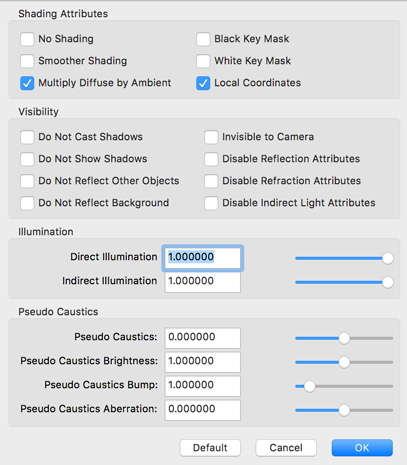Advanced Shading Dialog Box
In the Surface Window, click the Advanced... button to open the Advanced Shading dialog box.
| Advanced Shading |
|---|

|
Shading Attributes
- No Shading
- When selected, the surface is not shaded.
- Smoother Shading
- When selected, a local shading model (differing from the Phong shading model) is used to create smoother shading.
- Multiply Diffuse by Ambient
- When selected, the diffuse reflection is multiplied by the weight and color of the ambient light. As a result, lowering the diffuse weight will also lower the ambient light weight.
Deselecting this option will unlink the ambient light and diffuse reflection attributes, allowing them to be set individually. - Black Key Mask
- When selected, black areas of the diffuse reflection will inherit their surface attributes from the parent.
- White Key Mask
- When selected, white areas of the diffuse reflection will inherit their surface attributes from the parent.
- Local Coordinates
- When selected, mapping is done using local coordinates. In this case the mapping will move with objects inside a part that is transformed or inside a joint that is moved.
When unselected, mapping is done using global coordinates. In this case the mapping will not move with objects inside a transformed part or a moved joint.
This option is on by default.
Visibility Settings
- Do Not Cast Shadows
- When selected, shadows are not cast onto other objects.
- Do Not Show Shadows
- When selected, shadows cast by other objects are not shown on this surface.
- Do Not Reflect Other Objects
- When selected, other objects will not be reflected on this surface. Only the background will be reflected.
- Do Not Reflect Background
- When selected, the background will not be reflected on this surface. Only other objects will be reflected.
- Invisible to Camera
- When selected, all objects with this surface will be invisible to the camera. Shadows, reflections on other objects, refraction, and indirect energy used for global illumination are unaffected.
- Disable Reflection Attributes
- When selected, all objects with this surface will not be reflected onto other objects.
- Disable Refraction Attributes
- When selected, all objects with this surface will not be seen by other objects when refracted light passes through them.
- Disable Indirect Light Attributes
- When selected, all objects with this surface are ignored when calculating indirect energy for global illumination.
Important This setting only applies to Path Tracing and Photon Mapping. It is not compatible with Radiosity.
Note When using Radiosity, similar settings can applied with the Radiosity Attributes checkboxes in the Browser.
Illumination Settings
The direct and indirect light energy received by an object can be adjusted individually with the object's surface attributes.
This can be done to reduce the intensity of light received from light sources or global illumination for a particular object.
When combined with lightmaps, unique lighting effects can be expressed using the light sources in the scene and rendering speed can be improved.
- Direct Illumination
- Specifies the level of direct illumination received.
Smaller values result in a darker object (less direct illumination), while larger values result in a brighter object (more direct illumination).
When using global illumination, lowering the direct illumination value for objects that will not be lit directly, such as objects surrounded by walls and only lit indirectly, is effective in improving rendering speed.
A value of 0.0 will skip the direct illumination calculation entirely. - Indirect Illumination
- Specifies the level of indirect illumination received.
Smaller values result in a darker object (less indirect illumination), while larger values result in a brighter object (more indirect illumination).
Lowering the indirect illumination for objects that receive very little global illumination, such as transparent objects with very weak diffuse color or reflective mirrors, is effective in improving rendering speed.
A value of 0.0 will skip the indirect illumination calculation entirely.
Pseudo Caustics Settings
- Pseudo Caustics
- Adjusts the darkness of shadows cast by an object with transparency based on the direction of its surface normals.
This is used to simulate the phenomenon called caustics, in which reflected or refracted light is concentrated in patches, such as when waves at the surface of water create a dappled pattern on underwater objects. Pseudo Caustics is set to 0 by default, and is not applied. - Pseudo Caustics Brightness
- Adjusts the shadow depth of pseudo caustics. This setting becomes active when the Pseudo Caustics value is non-zero.
- Pseudo Caustics Bump
- Applies bump mapping to pseudo caustics. This setting becomes active when the Pseudo Caustics value is non-zero.
- Pseudo Caustics Aberration
- Changes the position of pseudo caustics shadows, simulating color aberration. This setting becomes active when the Pseudo Caustics value is non-zero.
Resetting the Advanced Shading Settings
Click the Default button to reset all options in the Advanced Shading dialog box to their default settings.